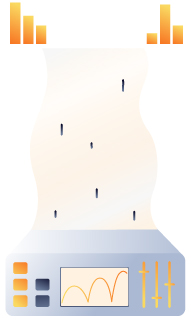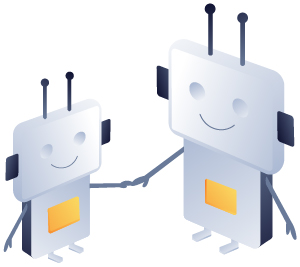Intro
2018 is making it into the history books as a year of the rise of AI-driven things and unseen before application of augmented reality, like AR shopping and even healthcare. With technology getting to the users closer than ever, 2018 also was forced to become a year of personal data privacy regulations with GDPR being the most drastic change there in 20 years.
What’s 2019 going to bring to the table in terms of technology? The year is just around the corner, so you should check out new tech opportunities it is about to bring in advance. This post has you covered on the top technology trends of 2019.
#1: Autonomous things
AI-powered autonomous things will continue assisting people and even replacing them in performing some simple actions. As for now, people learned how to put AI in robotics, vehicles, home appliance, drones, and intelligent agents. Actions that can be successfully performed by robots include tons of them, from harvesting to auto-piloting a vehicle and sorting unstructured big data.
With advancement in robotic development, the interaction of autonomous equipment with the world becomes more and more natural. For example, retail industry giants like Amazon and Alibaba (biggest Chinese retailer) have been successfully using robots in their warehouse management to move, collect, sort, and track the inventory. Following their example, Uber decided to delegate parking lots patrolling to the Knightscope robots, which by the way can record a video and stream it to a remote screen.
Of course, AI-driven devices aren’t close to having all the functions of the human brain (at least not yet, anyway), and the level of intelligence here varies drastically, but we still sure that AI development will have a high share in the industry in 2019. We’ve already explored applications of artificial intelligence in agriculture, finance, business, and healthcare, so you can check out our in-depth researches if interested.
#2: Augmented analytics

The collection and processing of big data is the primary duty of data scientists. With the beginning of an informational era, the amount of data produced by users reached unbearable size. Naturally, it came to a point when people became unable to collect, sort, process, and apply all the information they access on a daily basis.
Without incorporating relevant software, data science risk to turn into an unproductive activity with positive outcomes being a luck rather than a rule. The g
In the near future, data scientists will be seen as professionals to manage the algorithms and perform the final analysis of the data sorted out by AI-powered analytic tools, which in its turn will simplify the access to credible data insights.
#3: AI-driven development
The essence of AI-driven development lies in exploring the potential integration of artificial intelligence in the actual programming processes. Software development is a complex multi-layer process that requires engineers to keep full-blast attention at everything at once. This trend is aimed at making the programming more efficient, rapid, and error-free by delegating some coding tasks to the integrated AI-powered applications. Automated testing, code generation, and augmented analytics we’ve mentioned above altogether open the way to better programming products in the shorter amount of time.
Another direction this trend is moving us to is the use of AI applications not to just replacing a person for primitive actions, but for creating the whole new solutions analyzing their efficiency and usability beforehand. AI-based tools will be taken to the higher level of service when they can actually influence the end product assisting in the development and automating some important functions.
#4: Digital twins

In short, a digital twin is a virtual replication of a real-life process, product, or action. This virtual replication is targeting not only to mirror the real objects but also give us an option of implementing a change and see the consequences of it. For example, NASA actively uses digital twins for projecting new equipment. They create a digital twin, interact with it through sensors and analyze the data gathered by these sensors. Only if the team is fully satisfied with the outcome, a piece of equipment gets to the stage of physical (real) manufacture. This saves an enormous amount of money, time, resources, and prevents errors that could affect the entire business.
Despite the fact, the concept of digital twins has been around for more than fifteen years now, it’s the Internet of Things (IoT) that made it actually useful for modern users. Years ago, we could only imagine the work inside a business with no risky “what if” scenarios that could ruin your brand image and make a hole in your budget. The smartest entrepreneurs of our time support the movement towards minimal waste of all the possible resources including human labor, and the digital twin is a foremost technology behind it.
#5: Smart spaces
Continuing the themes of artificial intelligence and IoT, we have to also mention the trend of making spaces as smart as they can be. Brands are working towards creating an environment that would make the interaction between technology and users seamless, effortless, and instant. Smart spaces can be both digital and physical or a combination of both forming a unified ecosystem.
The tech stack needed to build an efficient smart space includes AI, machine learning, voice recognition, and edge computing among others. In 2019, we’ll see the expansion of assisting hardware and software used solely in offices or homes towards public use. We are moving towards making smarter not just the closest personal space around us, but providing our cities with their own intelligence to transform them for every resident and bring the community together.
#6 Edge computing
It’s been
In a nutshell, edge computing is a programming architecture aimed to deliver decentralized processing power. It belongs to the IoT technology with one crucial feature — it is specifically targeted to ultra-connected things. Namely, edge allows devices process data locally through a server being physically close to a user. Unlike the cloud computing that distributes on-demand software services from far away, edge computing offers us to use the hardware we own around us at its maximum potential thereby drastically shortening the latency levels and improving data security. In 2019, fields like healthcare and banking will be the foremost to incorporate edge in their enterprise software.
#7: Data privacy and ethics
The deeper information technology penetrates our lives, the more concerned users become over the safety of their personal data. In the upcoming year, companies will continue to demonstrate an increased ethics when it comes to private information of users, and not just the sharing of it, but also collecting, processing, and storing.
At the very start, all the tech enhancements were aimed at giving us an ultimate level of personalization, which reached a pivot point of turning into a constant feeling of a big brother watching you and listening to you literally all the time. Seeing how this affect the image of particular software, companies, and even information technology in general, the concern reached the governmental level. As a result, we’ve witnessed the implementation of the most important data privacy regulation in the last two decades — The EU General Data Protection Regulation (GDPR). The example of Europe Union is going to be followed by many regions worldwide setting up new standards of treating personal information of users.
#8: Blockchain

Although the majority of people still associate blockchain technology with just cryptocurrency, it has actually spread out a lot since the cryptocurrency boom. Businesses operating in healthcare, manufacture, and even government agencies already started adopting the blockchain-inspired solutions due to their resource effectiveness.
At its core, blockchain is a digital record of transactions constructed as a list of cryptographically signed transactional records shared between all the network users. It provides data safety and lets parties perform transactions without banks or other centralized entities which used to act as a guarantor of transaction legitimacy. Of course, the current state of this technology is rather immature and underexplored, however, the predictions here are beyond impressive. According to the Gartner, by the year 2030 blockchain will create $3.1 trillion business value.
#9: Voice assistants
With technology penetrating our daily lives, software engineers work towards simplifying the use of it or, in other words, try to get us back to basics when it comes to our communication with devices. Speaking is more natural for humans than, for example, typing, not to mention it is a lot easier for people of older age or with certain disabilities. Due to the rapid modernization of AI we’ve already talked a lot in this post, voice control over the software and hardware became possible.
Although voice recognition has been studied for years, users started really appreciating it in 2018. Consumer-facing voice assistant for homes have plenty of fans worldwide, and high-tech businesses are also implementing chatbots and virtual assistance making their workplace smarter. Voice search is something most of us get so used to these days, that it is forecasted by 2020, a half of online search requests will be sent by voice solely. Considering these impressive numbers, we’re more than certain that voice assistants will only
Summary
As you can see, AI will still lead the show in 2019 with augmentation, edge, and blockchain technologies by its side. The tendency of showing respect for personal user information will also secure its position worldwide and has all the chances to drastically change the whole industry. If all these tech trends seem to be overwhelming to you and you don’t know how to start implementing them in the daily life of your enterprise of startup, we’re here to answer any question.


 (6 votes, average: 4.83 out of 5)
(6 votes, average: 4.83 out of 5)